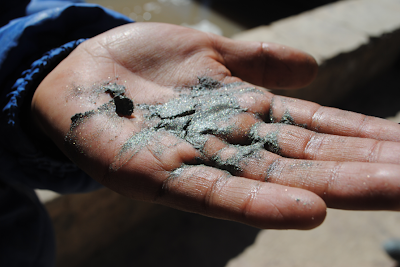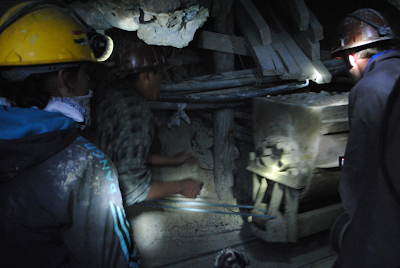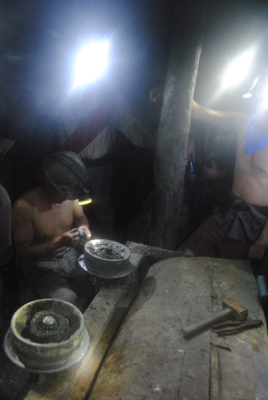The route to Potosi was stunning, yet the town could only be reached once the strong men of Bolivia with the assistance of a young man from Jersey pushed a less fortunate broken down bus off to the side of the road so that ours and others could pass, not an easy task on an upward slope at altitude! The main draw for the town of Potosi is the silver mine, a massive but deadly employer alleged to have claimed the lives of over eight million people. This death toll is in the most part owing to the original conquistadors upon discovering the quality and amount of silver held within, forced the indigenous workers to work without pay and in torrid conditions. Even today the life expectancy of a perfectly healthy man entering the mines is only ten years. Accidents are frequent for various reasons. Metal carts which weigh a ton even when empty career through the tunnels with no breaks and there isn’t always a place to get out of their way. Collapses occur from beams unable to support the above weight, dynamite explosions occur after an original unsuccessful detonation requires a miner to revisit the placement. Yet the most common killer like most things in life is the slow one, the gradual inhalation of harmful particles from working long shifts day in day out leading to acute silicosis, the lungs fill with fluid leading miners to the point of coughing up blood and eventual death from ‘the black lung’.
Against all these risks the mine offers the potential of wealth, albeit not much in comparison to its earlier mineral content as today only two kilograms of silver are retrieved per one hundred tons of extracted ‘ore’ compared to two hundred kilograms in the times of the Spaniards occupation which made Potosi the once upon a time wealthiest town in the world, more so that Paris and Rome. According to a documentary we watched on our first evening there are still over eight hundred children working in the mine today despite the risks. We would be visiting the mine ourselves and spending two hours often in space only big enough to crawl through and dodging carts the next day.
 |
| They couldn't have done it without me |
Owing to the industrial nature of the town we didn’t expect much. We were therefore more than pleasantly surprised when the vibrancy of the place emerged on that first evening as a young marching band paraded through the plaza. There were things going on until quite late, but we were getting up early to do the tour of the mine that we had booked with a company called Koala. We took a short bus ride to the depot where we would be gearing up with our wellies, trousers, overcoat, miner’s helmet and receive a short briefing from our assigned guide Danny. Dressing would be difficult as the temperature of the mine differentiates to a large extent depending on where in the mine you are. A knackered old bus then took us to the miner’s market where it was a custom for those taking tours to make a further contribution to the miners in addition to their small cut from our one hundred boliviano fee (about nine quid).
During a further hill climb in our rickety bus we bit into some of the alkali substance required to release the properties of the coca that help to combat altitude sickness. We briefly stopped for a viewpoint opportunity before the bus lead us to the entrance to the mine. Danny gathered all our gifts into a cloth sack and we gaped at this dark entrance, the outside spattered in the blood from cumulative llama sacrifices done whenever productively is low. Alas it was time to enter, so we turned our headlamps on and began our decent into the abyss! The first part wasn’t overly uncomfortable, the air was still quite fresh and the ceiling wasn’t very low although it was still necessary to keep your head down and dodge the odd half collapsed beam now and again. We stopped and gathered together just before the going was about to get a bit tougher. We were to be crawling down a small gap on a steep slope and two people from our group of eight decided that they had had enough and dropped out at this point.
Here Danny held an interesting question and answer session and provided us with some information about the history of the mine, much of my previous explanation coming from what he told us. He also told us when asked that he had worked in the mine for around two and a half years and that his poor farther still did to this day owing to previous unsuccessful ventures. Talk time was over and we needed to get our bums through this small tunnel. I decided to go at the front just behind Danny for the extra psychological boost that I couldn’t stop, panic or want to turn around because the other guys were behind me. It wasn’t too physically challenging but the key was to move through without dragging any limbs against any surfaces as this would generate a lot of dust and whilst many of us had masks or scarves to help filter it out, it made it more difficult to breath as the air quality reduced the further in we went.
 |
| Zoolander poses at the entrance to the mine |
 |
| Entering the tunnels |
 |
| The first stopoff before things got a little tight! |
 |
| The hole we descended into |
 |
| Stopping for a break |
 |
| Having my photo taken with dust mask |
It was nice to get out of that room and continue our cart dodging and miner visiting opportunities in a cooler climate. Danny took us to the fabled ‘Tio’ of this mine, the idol worshipped by the miners as soon as they are inside. Outside they are Catholics but this was the world of the devil. Offerings were evident all around the statuette. It was now time to start making our way out. For a little experiment we all turned off our lights to see how easy it was to negotiate the mines, the bottom line being that is was extremely difficult indeed. Arms on shoulders and heads cautiously lowered we made slow progress in the complete darkness until some caved in and needed to turn on their lights again. It soon became as cold in these tunnels as it had been warm in the previous ones to the extent of icicles forming from the wooden beams. Splashing through large puddles of unknown depths and squeezing past miners, daylight eventually emerged in what signified the end of the tunnel. We were all relieved to be out but had greatly enjoyed the experience and had established a new found respect for those who called this place their workplace day in day out.
 |
| Hanging out with the devil 'Tio' |
 |
| Icicles on the way out |





























No comments:
Post a Comment